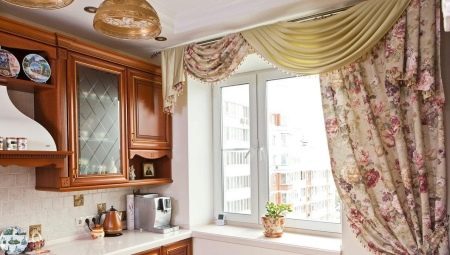To make the kitchen more comfortable and expressive, to hide possible window defects and design flaws - all this allows lambrequins. For the first time, windows began to be decorated in this way in France, and the word “lambrequin” is translated from French as “drapery”.
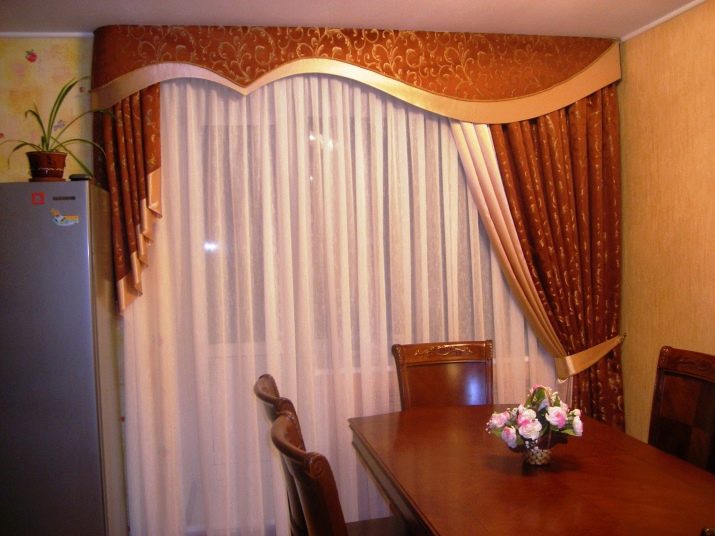
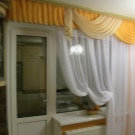
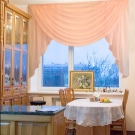
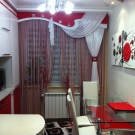
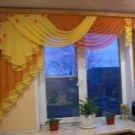
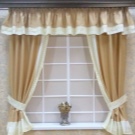
Features
Lambrequin is a a kind of home textile, this is the drapery at the top of the window. It performs many functions - it hides the fixing places of curtains and tulle, it is used to decorate the cornice, and finally, beautiful waves and draperies are attractive in themselves and become the decoration of the room.
Lambrequin is a complex construction. The upper horizontal part is called swag. It can be either symmetric or asymmetric. Jabot - it is a draping vertically descending element that can have a different length (depending on the size of the window, the design features of the kitchen). Part of the lambrequins connecting with the frill is called tie.
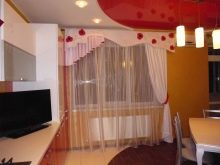
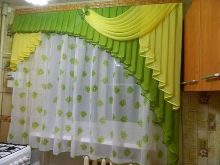
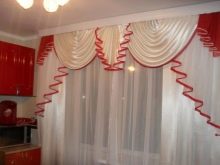
Sometimes you can see how the panels of lambrequins are thrown over the cornice. These items are called peroxides their ends usually hang down freely, adding splendor and solemnity to the interior. Puffs called lush folds, which can also be found in the design of lambrequins.
Often, lambrequins are complemented by ruffles, lace, tassels. However, these elements are optional. Their presence is determined solely by the style of the kitchen and the wishes of the owners.
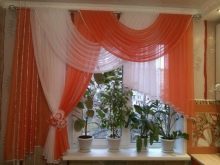

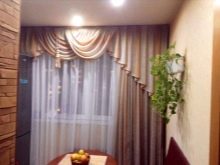
Kinds
Depending on the location on the window and the features of the patterns lambrequins can be symmetric and asymmetric. The former will successfully fit into the kitchen of the correct square or rectangular shape, emphasize its harmony.
Hide the "angularity" of the room, make it softer soft draperies, lambrequins-arches, as well as models hanging down in beautiful folds. An asymmetric analogue will hide some imperfections in the layout or arrangement of furniture in the room.
Such products are otherwise called one-sided, they are also recommended for small kitchens.
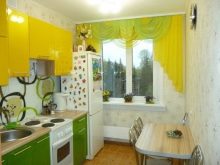
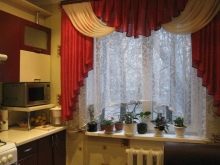

Depending on the type of tissue used, several types of lambrequins are distinguished.
- Soft. They are made from soft, well-draped fabrics. This is the most common option in the kitchen, because it brings a sense of comfort and warmth to it. In addition, soft lambrequins are quite easy to care for.
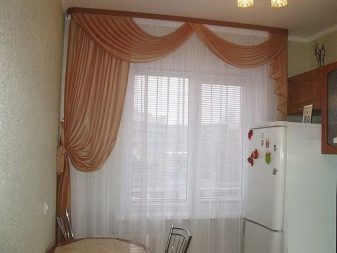
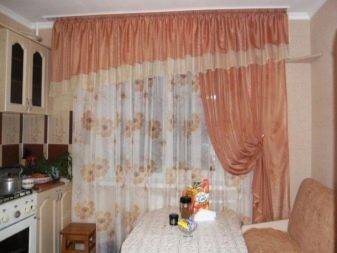
- Hard (bando). These are lambrequins made of curtain fabric, but having a rigid, stiff base. They do not form folds and draperies; they can have evenly cut or curly edges.
Under the rigid lambrequin it is convenient to mask the fastening system and the cornice itself, this element brings a solemnity effect to the room. It is practical (does not lose shape), but difficult to care for.


- Combined. They combine the features of the first two types, for example, the top of such lambrequins can be rigid, skeleton, and soft fabrics are used below. The combined design is suitable for spacious kitchens with large windows and high ceilings.
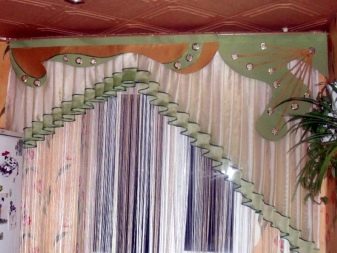
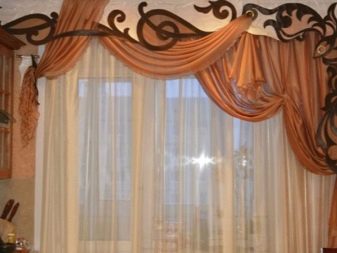
Materials
The fabric for kitchen lambrequins should be easy to care for, not afraid of numerous washes, elevated temperatures. Ideally, be impregnated with special fire and water repellent compounds. For the kitchen, many housewives prefer natural materials - linen, cotton, viscose. Synthetic analogues are less commonly used.
The most inappropriate option can be called heavy expensive fabrics (brocade, velvet).
In most cases, they are inappropriate in the kitchen, do not coincide with the style and purpose of the room. Heavy fabrics, difficult to care for, quickly absorb extraneous odors.
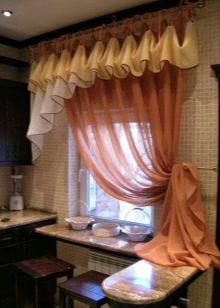

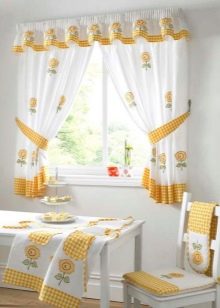
The most common fabrics for sewing lambrequins are the following:
- veil - allows you to create light, airy designs, drapes well;
- organza - stylish and original design, drapes well, looks respectable;
- felt – dense material that does not form folds is also suitable for creating dense figured structures;
- chiffon - Another version of a light and flowing fabric that will help visually expand the room, add nobility to it;
- kapron - kapron products look unusual and elegant, but very capricious in leaving;
- atlas - allows you to create respectable, noble design options, the material looks very stylish.

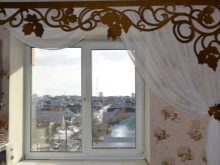
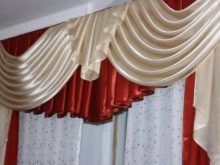
Design options
Lambrequins can act as a color accent or create the so-called effect of blurry borders. In the first case, the color of the lambrequins will be contrasting, instantly attracting attention. In the second - matching the shades of walls and furniture. Popular colors include the following options.
- It is easy to get a beautiful contrasting window design with red lambrequins. In general, this shade is suitable for most kitchen styles, the main thing is to choose a design and a suitable saturation of red.
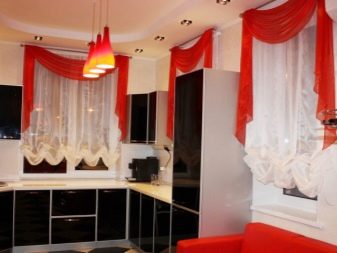
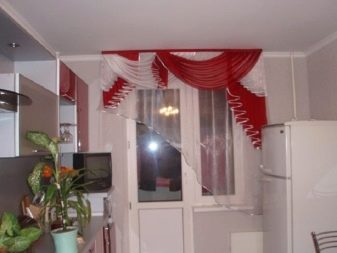
- In some interiors, the white version may also be contrasting. White lambrequins look impeccably, effectively, they will help emphasize other colors of the room.

- Green is considered successful for the kitchen., as well as shades from the same and close palette (olive, light green, lime). It calms, makes the interior harmonious.
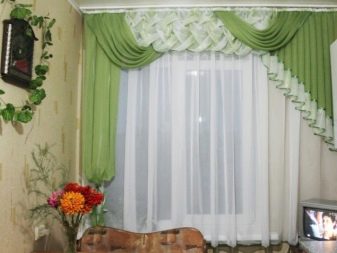
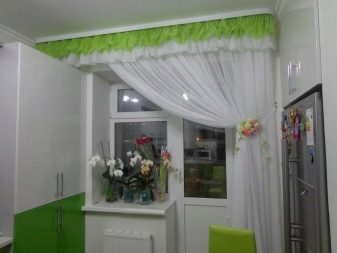
- To bring energy, sunny mood and lightness to the kitchen, yellow shades of lambrequins will help. Such options are especially relevant for the Provence style.

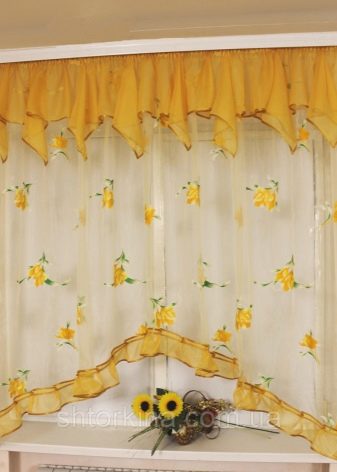
- The use of the interior will be deeper, more thorough, sound. brown lambrequins. They are especially well combined with wooden furniture.
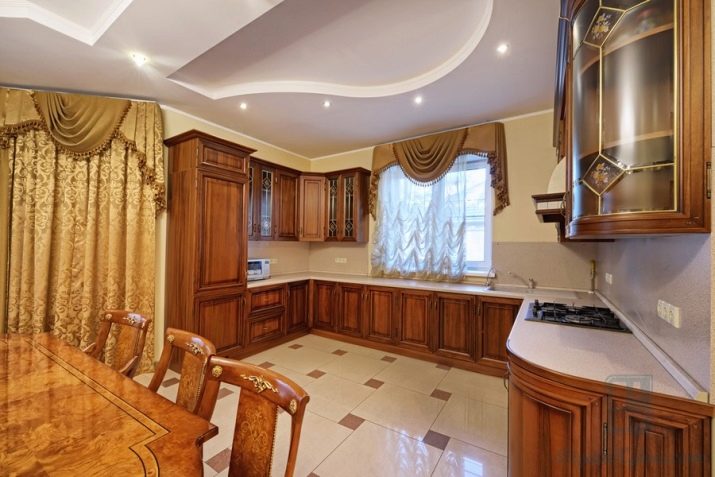
- Blue tint (as well as cyan, turquoise, deep blue) it adds harmony and a certain stability to the room, but experts say that this color reduces appetite, it is contemplative, thoughtful, and therefore not the best for the kitchen.

- Pink modelon the contrary, improves appetite, fills the room with warmth, comfort and ease.

- Feeling of coolness and solemnity give lilac and violet shades of designs, it is better to dilute them with white, pastel, beige tones.
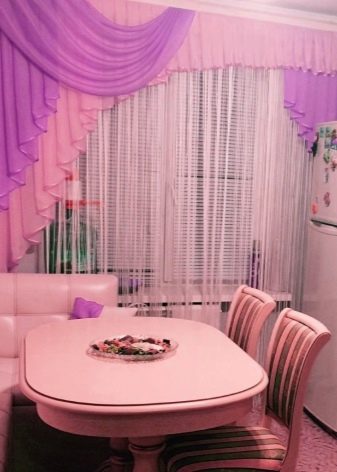
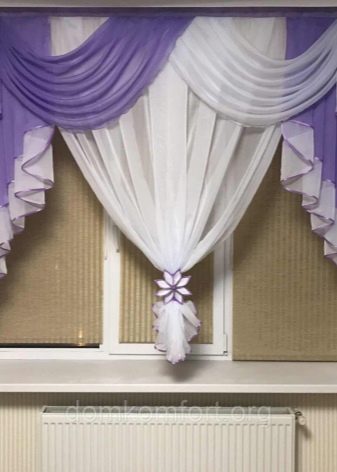
As for the design features, the following varieties of decorative elements of lambrequins are distinguished:
- cocktail - a textile element representing a symmetric cascade; it is laid out with vertical folds converging in the center;
- jabot (de jabot) - has the form of waves hanging down at the edges of a window opening and emphasizing its borders;
- cascade - It is located on the side of the curtains, has the appearance of zigzags, which is emphasized by using contrasting fabric for the lining.

Classical products are usually symmetrical cut, complex draperies, dense fabrics. Modern analogues can be both complex and concise. Design novelties just mean models without folds and draperies - these are semi-rigid and rigid models.
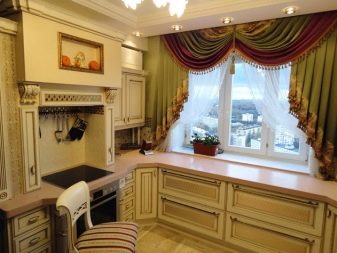
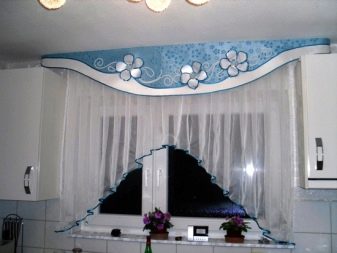
How to choose?
The optimal height of the lambrequins should not exceed 1/4 of the length of the curtains. Their length should correspond to the length of the cornice. It is important to consider the location of furniture in the kitchen - too long models are dangerous to hang near the stove.
It is important to combine lambrequins and the general style of the room, window sizes, design. For spacious kitchens with a good-quality set in a classic style, you should choose a volumetric lambrequin, a frame version is also suitable. For small rooms, on the contrary, more concise and lightweight analogues are suitable.
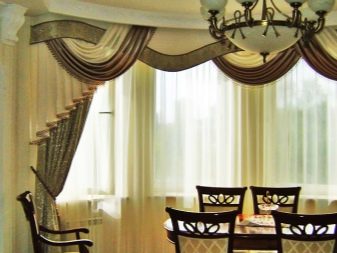
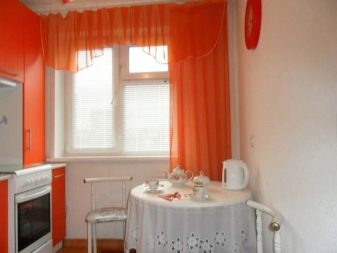
Visually increase the room, as well as raise the ceilings will help the use of lambrequins of light shades. It is better to fix them to the ceiling cornice. For a kitchen with a balcony door, it is recommended to purchase asymmetric products so that the opening door does not violate the design of curtains and lambrequins.
In difficult cases, it is difficult to find finished products, but they can be sewn to order. In this case, it will be possible to get lambrequins that most closely match your desires.
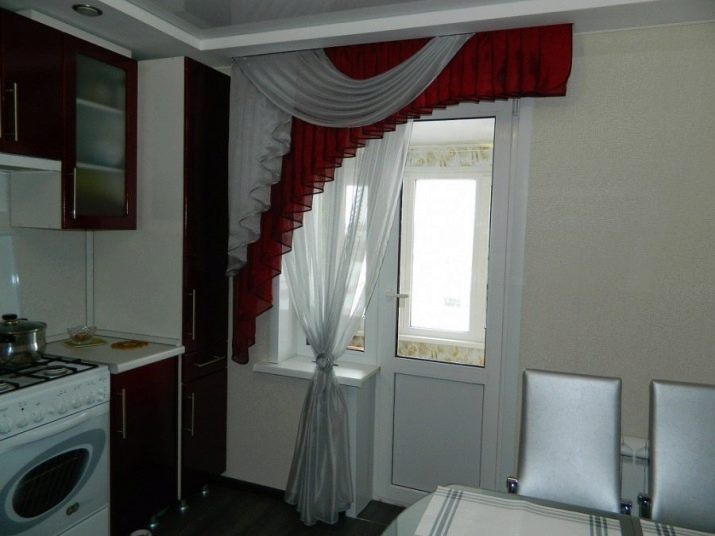
You should think about the features of care.. Many complex designs from heavy expensive fabrics are cleaned only in dry cleaning. Lambrequins made from natural fabrics get dirty faster, absorb odors, they will have to be washed more often. Besides, when washing, natural matter can crumple, which leads to additional chores.
Synthetic and mixed fabrics are easier to care for, look stylish and noble. However, when the smallest spark hits the fabric, it will flare up. Ideally, if the model has a fireproof and waterproof impregnation.
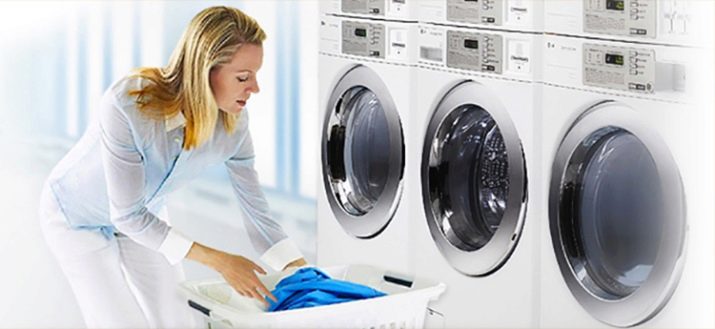
Beautiful examples
Lambrequins go well with Roman shades. Such a tandem is especially successful in small kitchens. Lambrequin allows you to soften and make more comfortable strict and concise Roman curtains. It is advisable to make them from one fabric. An acceptable option is dense one-color Roman curtains and translucent monophonic lambrequins in the same gamut.

The kitchen is in a classic style. A soft curtain in soft draperies and a transparent tulle are harmoniously combined with soft lambrequins.
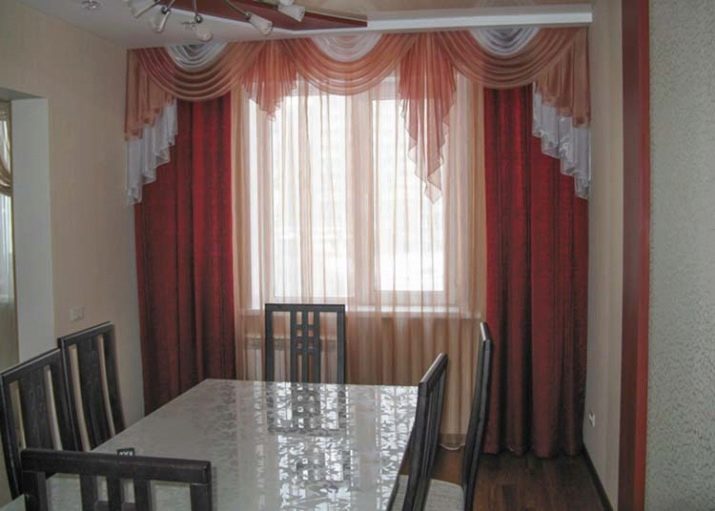
To color curtains It is recommended to choose dense or combined lambrequins to match. Colored textiles are usually matched to the tone of furniture or walls; it looks no less attractive in combination with light plain walls.
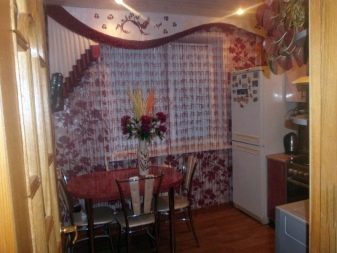

Blinds for the kitchen - It is practical and convenient to use, but they can look too strict and boring. To avoid this, pleated lambrequins will help, which spread through the cornice and descend beautifully.
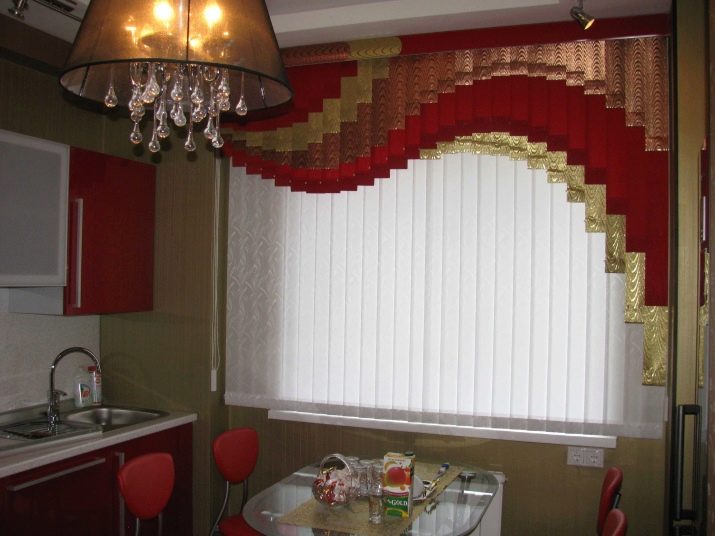
The next example is Bright illustration of a country style kitchen. Floral and vegetable ornament on lambrequins is one of the signs of this style. The overall color scheme of the product is combined with warm brown and pastel shades of furniture. Natural material also allows you to emphasize the lightness, environmental friendliness of the room.
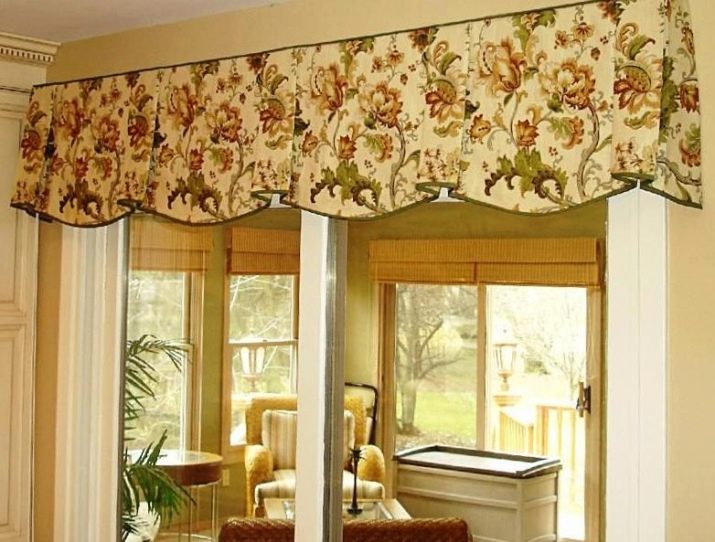
The spacious classic dining room looks stylish and sophisticated openwork tulle on the windows. To give the interior individuality and elegance allows carved pelmet.
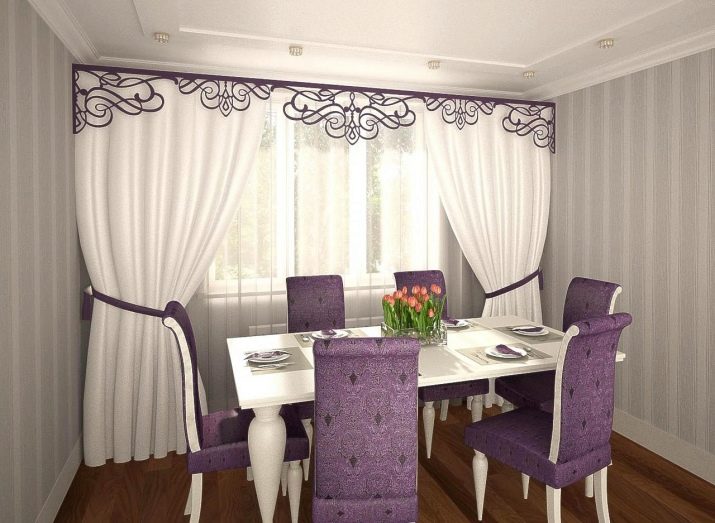
For kitchen rustic style the option of simple design lambrequins made of natural fabric became optimal. It seems that these are just curtains, braided. An olive shade brings coolness to the room, it is associated with calm and vitality.
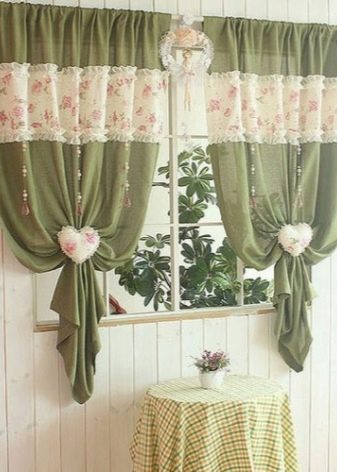
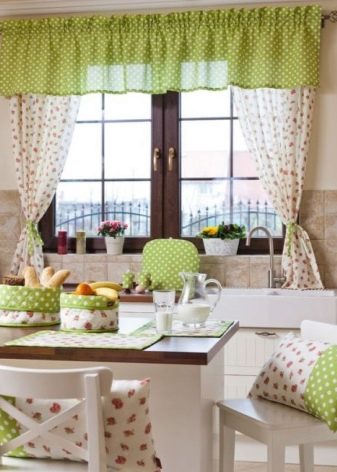
The next interior of the kitchen-dining room is made in the baroque style. The best addition to the curtains were multi-layer two-tone lambrequins made of heavy fabrics. They have a complex structure and form numerous draperies. All this emphasizes the luxury of the interior.
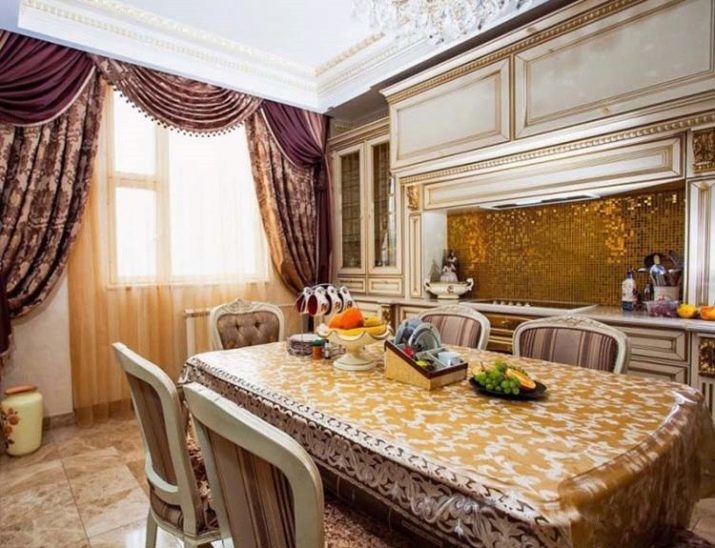
See how to sew a pelmet into the kitchen in the next video.
